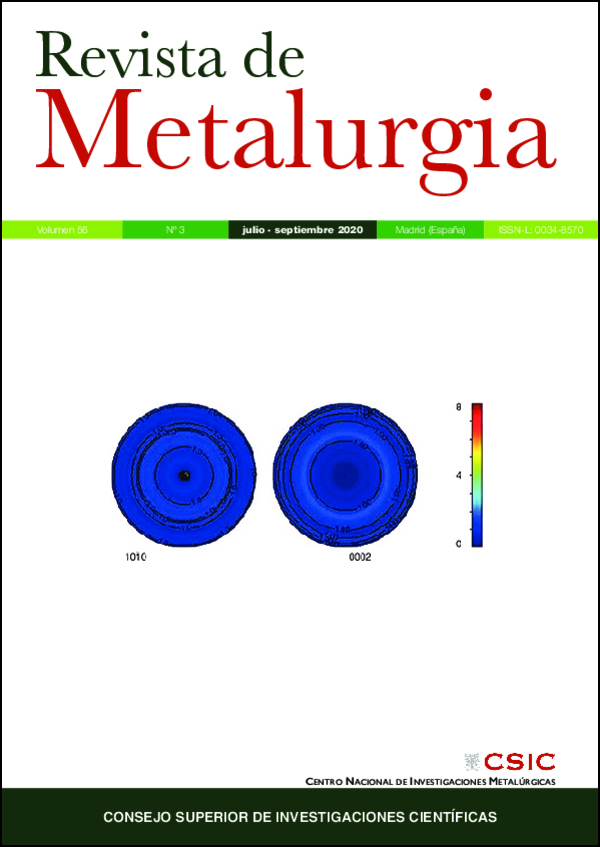Numerical study of the effect of first ring profile type on hydrodynamic performance of the lubricant in diesel engine
DOI:
https://doi.org/10.3989/revmetalm.177Keywords:
Cylinder liner, Diesel engine, Gas dynamics, Hydrodynamic lubrication, Oil film thickness, Piston ring, Power lossesAbstract
For different operating conditions of an internal combustion engine, the piston-ring-liner compartment represents one of the largest sources of friction and power losses. The present paper is a contribution to evaluate the effect of the compression ring profile on the main tribological performance of the lubricant in a four-stroke diesel engine. A one-dimensional analysis was developed using GT-Suite software for the hydrodynamic lubrication between the compression piston ring and the cylinder wall. A numerical method was applied to analyze the influence of different ring geometrical designs during the working cycle on oil film thickness, frictional force, power losses. The Takigushi simulation model was used to validate and verify the developed numerical model. The results obtained showed a relatively good qualitative and quantitative compatibility between the two applied models. The developed numerical model allows the investigation of the influence of ring design parameters to improve the tribological performance of piston engines.
Downloads
References
Balakrishnan, S., Rahnejat, H. (2005). Isothermal transient analysis of piston skirt-to-cylinder wall contacts under combined axial, lateral and tilting motion. J. Phys. D Appl. Phys. 38 (5), 787-799. https://doi.org/10.1088/0022-3727/38/5/018
Chaudhari, T., Sutaria, B. (2016). Investigation of friction characteristics in segmented piston ring liner assembly of IC engine. Perspect. Sci. 8, 599-602. https://doi.org/10.1016/j.pisc.2016.06.032
Cho, J., Jang, S. (2004). Effects of skirt profiles on the piston secondary movements by the lubrication behaviors. Int. J. Auto. Techn. 5 (1), 23-31.
Delprete, C., Razavykia, A. (2018). Piston ring-liner lubrication and tribological performance evaluation: A review. J. Eng. Tribol. 232 (2), 193-209. https://doi.org/10.1177/1350650117706269
Delprete, C., Razavykia, A., Baldissera, P. (2019). Detailed analysis of piston secondary motion and tribological performance. Int. J. Engine Res. 21 (9), 1647-1661. https://doi.org/10.1177/1468087419833883
Gulwadi, S.D. (2000). Analysis of tribological performance of a piston ring pack. Tribol. T. 43 (2), 151-162. https://doi.org/10.1080/10402000008982325
Guo, Y.B., Lu, X.Q., Zou, D.Q., He, T., Li, W.Y. (2011). Analysis of Piston Ring Lubrication with Different Lubricant Supply. Adv. Mat. Res. 200, 700-706. https://doi.org/10.4028/www.scientific.net/AMR.199-200.700
Jeng, Y.R. (1992). Theoretical analysis of piston-ring lubrication. Part I-fully flooded lubrication. Tribol. T. 35 (4), 696-706. https://doi.org/10.1080/10402009208982174
Mohamad, S.A., Lu, X., Zheng, Q. (2015). Numerical modeling of lubrication of piston ring of two-stroke marine diesel engine considering the effect of multi-scale grooves on the cylinder liner. P. I. Mech. Eng. J.-J. Eng. 229 (8), 989-1002. https://doi.org/10.1177/1350650114556400
Morris, N., Rahmani, R., Rahnejat, H., King, P.D., Fitzsimons, B. (2013). The influence of piston ring geometry and topography on friction. P. I. Mech. Eng. J.-J. Eng. 227 (2), 141-153. https://doi.org/10.1177/1350650112463534
Notay, R.S., Priest, M., Fox, M.F. (2019). The influence of lubricant degradation on measured piston ring film thickness in a fired gasoline reciprocating engine. Tribol. Int. 129, 112-123. https://doi.org/10.1016/j.triboint.2018.07.002
Radakovic, D.J., Khonsari, M.M. (1997). Heat Transfer in a Tin-Film Flow in the Presence of Squeeze and Shear Thinning; Application to Piston Rings. J. Heat Transfer. 119 (2), 249-257. https://doi.org/10.1115/1.2824217
Sonthalia, A., Kumar, C.R. (2013). The effect of compression ring profile on the friction force in an internal combustion engine. Tribology in Industry 35 (1), 74-83.
Soualmia, A., Bouchetara, M. (2015). Numerical modeling of the hydrodynamic behavior of the couple piston liner. Mechanics 21 (6), 450-456. https://doi.org/10.5755/j01.mech.21.6.7035
Srinadh, M., Rajasekhara, K.B., (2015). Static and Thermal Analysis of Piston and Piston Rings. IJEMAS 3 (8), 51-58.
Takiguchi, M., Harigaya, Y., Suzuki, M. (2003). Analysis of oil film thickness on a piston ring of diesel engine: Effect of oil film temperature. J. Eng. Gas Turbines Power 125 (2), 596-603. https://doi.org/10.1115/1.1501078
Tian, T. (1997). Modelling the performance of the piston ring pack in internal combustion engines. Thesis Ph. D., Massachusetts Institute of Technology.
Usman, A., Park, C.W. (2016). Optimizing the tribological performance of textured piston ring-liner contact for reduced frictional losses in SI engine: Warm operating conditions. Tribol. Int. 99, 224-236. https://doi.org/10.1016/j.triboint.2016.03.030
Wakuri, Y., Soejima, M., Ejima, Y., Hamatake, T., Kitahara, T. (1995). Studies on friction characteristics of reciprocating engines. SAE International (Technical Paper 952471). https://doi.org/10.4271/952471
Wannatong, K., Chanchaona, S., Sanitjai, S. (2008). Simulation algorithm for piston ring dynamics. Simul. Model. Pract. Th. 16 (1), 127-146. https://doi.org/10.1016/j.simpat.2007.11.004
Zavos, A.B., Nikolakopoulos, P.G. (2015). Simulation of piston ring tribology with surface texturing for internal combustion engines. Lubr. Sci. 27 (3), 151-176 https://doi.org/10.1002/ls.1261
Published
How to Cite
Issue
Section
License
Copyright (c) 2020 Consejo Superior de Investigaciones Científicas (CSIC)

This work is licensed under a Creative Commons Attribution 4.0 International License.
© CSIC. Manuscripts published in both the printed and online versions of this Journal are the property of Consejo Superior de Investigaciones Científicas, and quoting this source is a requirement for any partial or full reproduction.
All contents of this electronic edition, except where otherwise noted, are distributed under a “Creative Commons Attribution 4.0 International” (CC BY 4.0) License. You may read the basic information and the legal text of the license. The indication of the CC BY 4.0 License must be expressly stated in this way when necessary.
Self-archiving in repositories, personal webpages or similar, of any version other than the published by the Editor, is not allowed.
















